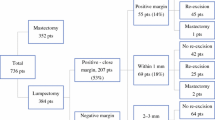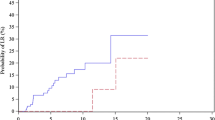Abstract
Background Invasive lobular breast carcinoma is known for its multicentricity and is associated with a higher incidence of incomplete excision after breast-conserving therapy. The aim of the study was to examine the influence of positive surgical margins on the local recurrence rate in patients diagnosed with invasive lobular cancer and treated with breast-conserving therapy. Methods All 416 women diagnosed with invasive lobular breast cancer and undergoing breast-conserving treatment between 1995 and 2002 were selected from the population-based Eindhoven Cancer Registry. Their medical charts were reviewed and detailed information was collected. Results The risk of margin involvement was 29% after the first operation and 17% when taking into account the final margin status of the patients undergoing re-excision. During follow-up, 18 patients developed a local recurrence. The 5 year actuarial risk of developing a local recurrence was 3.5% (95% confidence interval 2.5–4.5) and the 8 year risk was 6.4% (95% confidence interval 4.7–8.0). There was no influence of positive surgical margins on the risk of local recurrence, neither in the univariate analysis nor after adjustment for age, tumour size, nodal status and adjuvant systemic treatment. Conclusion Patients with invasive lobular cancer, treated with breast-conservation, have a low risk of local recurrence, despite their high risk of having a microscopically incomplete excision of the tumour.


Similar content being viewed by others
References
The World Health Organization Histological Typing of Breast Tumors–Second Edition (1982) The World Organization. Am J Clin Pathol 78(6):806–816
Wellings SR, Jensen HM, Marcum RG (1975) An atlas of subgross pathology of the human breast with special reference to possible precancerous lesions. J Natl Cancer Inst 55(2):231–273
Fisher ER, Gregorio RM, Fisher B, Redmond C, Vellios F, Sommers SC (1975) The pathology of invasive breast cancer. A syllabus derived from findings of the National Surgical Adjuvant Breast Project (protocol no. 4). Cancer 36(1):1–85
Martinez V, Azzopardi JG (1979) Invasive lobular carcinoma of the breast: incidence and variants. Histopathology. 3(6):467–488
Verkooijen HM, Fioretta G, Vlastos G et al. (2003) Important increase of invasive lobular breast cancer incidence in Geneva, Switzerland. Int J Cancer 104(6):778–81
Li CI, Anderson BO, Daling JR, Moe RE (2003) Trends in incidence rates of invasive lobular and ductal breast carcinoma. JAMA 289(11):1421–1424
Sastre-Garau X, Jouve M, Asselain B, et al. (1996) Infiltrating lobular carcinoma of the breast. Clinicopathologic analysis of 975 cases with reference to data on conservative therapy and metastatic patterns. Cancer. 77(1):113–120
Yeatman TJ, Cantor AB, Smith TJ et al. (1995) Tumor biology of infiltrating lobular carcinoma. Implications for management. Ann Surg 222(4):549–559; discussion. 559–561
Silverstein MJ, Lewinsky BS, Waisman JR, Gierson ED, Colburn WJ, Senofsky GM et al. (1994) Infiltrating lobular carcinoma. Is it different from infiltrating duct carcinoma? Cancer. 73(6):1673–1677
Moore MM, Borossa G, Imbrie JZ et al. (2000) Association of infiltrating lobular carcinoma with positive surgical margins after breast-conservation therapy. Ann Surg 231(6):877–882
Peiro G, Bornstein BA, Connolly JL (2000) The influence of infiltrating lobular carcinoma on the outcome of patients treated with breast-conserving surgery and radiation therapy. Breast Cancer Res Treat 59(1):49–54
Chung MA, Cole B, Wanebo HJ, Bland KI, Chang HR (1997) Optimal surgical treatment of invasive lobular carcinoma of the breast. Ann Surg Oncol 4(7):545–550
Singletary SE, Patel-Parekh L, Bland KI (2005) Treatment trends in early-stage invasive lobular carcinoma: a report from the National Cancer Data Base. Ann Surg 242(2):281–289
Holland PA, Shah A, Howell A, Baildam AD, Bundred NJ (1995) Lobular carcinoma of the breast can be managed by breast-conserving therapy. Br J Surg 82(10):1364–1366
Bouvet M, Ollila DW, Hunt KK, Babiera GV et al. (1997) Role of conservation therapy for invasive lobular carcinoma of the breast. Ann Surg Oncol 4(8):650–654
Kurtz JM, Jacquemier J, Torhorst J et al. (1989) Conservation therapy for breast cancers other than infiltrating ductal carcinoma. Cancer 63(8):1630–1635
Schnitt SJ, Connolly JL, Recht A, Silver B, Harris JR (1989) Influence of infiltrating lobular histology on local tumor control in breast cancer patients treated with conservative surgery and radiotherapy. Cancer 64(2):448–454
Poen JC, Tran L, Juillard G et al. (1992) Conservation therapy for invasive lobular carcinoma of the breast. Cancer 69(11):2789–2795
Salvadori B, Biganzoli E, Veronesi P, Saccozzi R, Rilke F (1997) Conservative surgery for infiltrating lobular breast carcinoma. Br J Surg 84(1):106–109
White JR, Gustafson GS, Wimbish K et al. (1994) Conservative surgery and radiation therapy for infiltrating lobular carcinoma of the breast. The role of preoperative mammograms in guiding treatment. Cancer 74(2):640–647
Mai KT, Yazdi HM, Isotalo PA (2000) Resection margin status in lumpectomy specimens of infiltrating lobular carcinoma. Breast Cancer Res Treat 60(1):29–33
Morrow M, Keeney K, Scholtens D, Wei J, Steel J, Khan SA (2006) Selecting patients for breast-conserving therapy: the importance of lobular histology. Cancer 106(12):2563–2568
Newman LA, Kuerer HM (2005) Advances in breast conservation therapy. J Clin Oncol 23(8):1685–1697
Voogd AC, Nielsen M, Peterse JL et al. (2001) Differences in risk factors for local and distant recurrence after breast-conserving therapy or mastectomy for stage I and II breast cancer: pooled results of two large European randomized trials. J Clin Oncol1.9(6):1688–1697
Rutgers EJ, Nortier JW, Tuut MK et al. (2002) [Dutch Institute for Healthcare Improvement guideline, “Treatment of breast cancer”]. Ned Tijdschr Geneeskd 146(45):2144–2151
Author information
Authors and Affiliations
Corresponding author
Rights and permissions
About this article
Cite this article
van den Broek, N., van der Sangen, M.J.C., van de Poll-Franse, L.V. et al. Margin status and the risk of local recurrence after breast-conserving treatment of lobular breast cancer. Breast Cancer Res Treat 105, 63–68 (2007). https://doi.org/10.1007/s10549-006-9431-5
Received:
Accepted:
Published:
Issue Date:
DOI: https://doi.org/10.1007/s10549-006-9431-5




